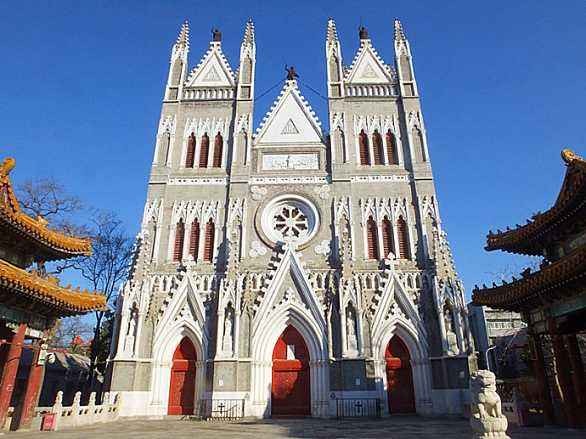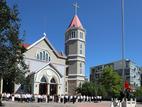Among the four major Catholic churches in Beijing, Xishiku Church is the largest one. This church is commonly known as the "The North Church" and is now the cathedral of the Catholic Diocese of Beijing.
The establishment of the Xishiku Church is quite legendary. Emperor Kangxi, who was always busy with the nation’s politics, suddenly fell ill and asked many doctors for help, but there was no cure. At last, two Jesuits, Jean de Fontaney and Claude de Visdelou (one source said Jean-Francois Gerbillon and Joachim Bouvet) offered the medicine called Quinine, and the emperor was healed. The missionaries could have asked for material rewards for helping to heal the emperor’s illness, but instead, they asked to build churches and spread the gospel instead. So Emperor Kangxi assigned a section of land on which the Jesuits could build a church. The church was finished in 1703 and named the Church of the Savior. Kangxi's donated a plaque for the newly-built church on which was written: "Wan You Zhen Yuan" (All things have their true origins), which shows his support for Catholicism at that time.
But the good times did not last long. Because of the dispute between China and the West over customary rituals, the Qing dynasty launched a 100-year ban on religion. Although the Church of the Savior was opened during the Yongzheng and Qianlong Periods, in the seven years of the Daoguang Period, the North Church was confiscated and demolished. But with the outbreak of the Opium War, the 100-year ban on religion ended. After the Second Opium War, the Catholic Church was again given the site of the North Church.
In 1868, Bishop Joseph-MartialMouly C.M. built a Gothic structure on the original site of the North Church. However, from the Forbidden City the Empress Dowager Cixi was very dissatisfied with the sound of the church bell and the height of the building. So she negotiated with the church and asked them to move to Xishiku. The Qing government funded the construction of a new church. In this way, the North Church came to Xishiku and was completed in 1888.
In the Boxer Rebellion, more than 10,000 Boxers and the Qing army besieged the Xishiku Church, but in the two-month battle, they could not conquer it. Although the Xishiku Church was damaged, it was not destroyed. After the Boxer Rebellion, the North Church was rebuilt in its current architectural style.
During the "Xiantang Xianmiao" (Offering the hall and the temple) Movement in 1958, the Xishiku Church was forced to close. Many precious books and documents collected in the church were taken out of the church and handed over to the Beijing Library. By 1985 the new religious policy was implemented, the Xishiku Church was repaired, and the mass was restored. In 1984, Xishiku Church was listed as a cultural relics protection site in Beijing, and in June 2006, it was listed in the sixth group of national key cultural relic sites.
The Xishiku Church is a typical Gothic building. The lobby has a cruciform shape, with a construction area of about 2200 square meters, a height of 16.5 meters, and the bell tower spire is about 31 meters high. There is a platform in front of the hall, white marble jade railings on three sides, and the main altar, suffering hall and chanting tower in the lobby. On both sides of the main entrance of the lobby, there are two Chinese-style pavilions. The buildings belonging to the North Church include a monastery, library, rear garden, printing house, orphanage, hospital, Guanghua Girls' High School, and a residence for priests.
There are three pointed arch entrances on the south facade of the North Church. Inside the church, a giant column supports the golden vault, surrounded by 80 stained glass windows. There is an oil painting of the Virgin Mary holding Jesus in the hall, but the Virgin Mary and Jesus are wearing the clothes of the empress and emperors of the Qing Dynasty, which is an example of incorporating Chinese characteristics into Christian artwork.
- Translated by Kevin Feng











